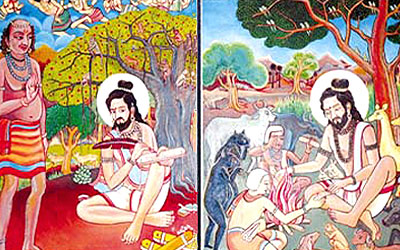 It has been asserted that Brihatkatha was composed in the seventh century. This book has also been mentioned by Trivikrama in his Campu and by Somadeva Suri in Ya‡astilaka. Brihatkatha means "Ocean of stories". Gunadhya was born at Pratisthita or Pratisthana on the Godavari River as a reincarnation of Malyavant. Gunadhya vows to use Sanskrit, Prakrit or the vernacular language in his book. It is accomplished finally and Gunadhya wanders dejected in the Vindhya. Here Kanabhuti meets him and narrates the tales that he learned from Vararuchi. Gunadhya in the introductory part of his work does mention that he used a legend of Vararuchi as the basis of his composition.
It has been asserted that Brihatkatha was composed in the seventh century. This book has also been mentioned by Trivikrama in his Campu and by Somadeva Suri in Ya‡astilaka. Brihatkatha means "Ocean of stories". Gunadhya was born at Pratisthita or Pratisthana on the Godavari River as a reincarnation of Malyavant. Gunadhya vows to use Sanskrit, Prakrit or the vernacular language in his book. It is accomplished finally and Gunadhya wanders dejected in the Vindhya. Here Kanabhuti meets him and narrates the tales that he learned from Vararuchi. Gunadhya in the introductory part of his work does mention that he used a legend of Vararuchi as the basis of his composition.
Gunadhya is told to record them in Paisachi dialect which is the language of the goblins. His disciples take the enormous work to king Satavahana. It is rejected by him. Gunadhya recites it to the beasts and birds and burn the manuscript as he proceeds. After the marvel is disclosed the king saves one-seventh of the 700,000 Slokas of the original, the tale preserved in the Brihatkatha. The original text is misplaced. It has been preserved partially in three Sanskrit versions -Brihatkatha Manjari by Kshemendra, Brihatkatha- Lokasamgraha by Budhaswamin of Nepal and Katha-Saritsagara of Somadeva. The Tamil version is known as Perunkkottai. Gunadhya`s epic was a bourgeois epic.
Ujjain or Kausambi was the scene where Gunadhya derived lot of inspiration which is different from the place where he was in royal honour and composed Brihatkatha. The date of Gunadhya is uncertain. However it has been asserted that Gunadhya did not belong later than 500 A.D. The form of his mammoth work is also questionable as the Kashmirian version suggests that this work was produced in Shlokas. Dandin suggests that it was written in prose.
The content of the Brihatkatha is also shrouded in mystery. He composed Brihatkatha based on three sources. From Ramayana he got the motif of the search of a husband for a wife cruelly stolen from him soon after a happy marriage. From Buddhist legends and other traditions of Ujjain and Kausambi he was familiar with the tales of Pradyuta, Mahasena and Udayana. He also knew many tales of sea-voyages and strange adventures. From the latter source and Buddhist legend he derived the conception of the monarch who is the secular counterpart of the Buddha.
Naravahanadatta who is the hero of his creation is born with the thirty-two auspicious signs which assure him Buddha hood if he enters the austere life. The empire is a fairy land. The realm of the Vidyadharas dwells beyond the dreadful defenses of the Himalayas. The Vidyadharas is a contamination of the old ideas of the Gandharvas with ideas that have been derived from the mysterious powers of Hindu and Buddhist saints and ascetics. The hero is the son of Udayana. The Ramdyaipi lends the crucial element of the plot, the rape of Madanamansuka or Madanamanjuka by Manasavega. The efforts of her husband to discover her in which he is helped by his faithful minister Gomukha is one of the major part of the plot. He captures the empire of the Vidyadharas.



















